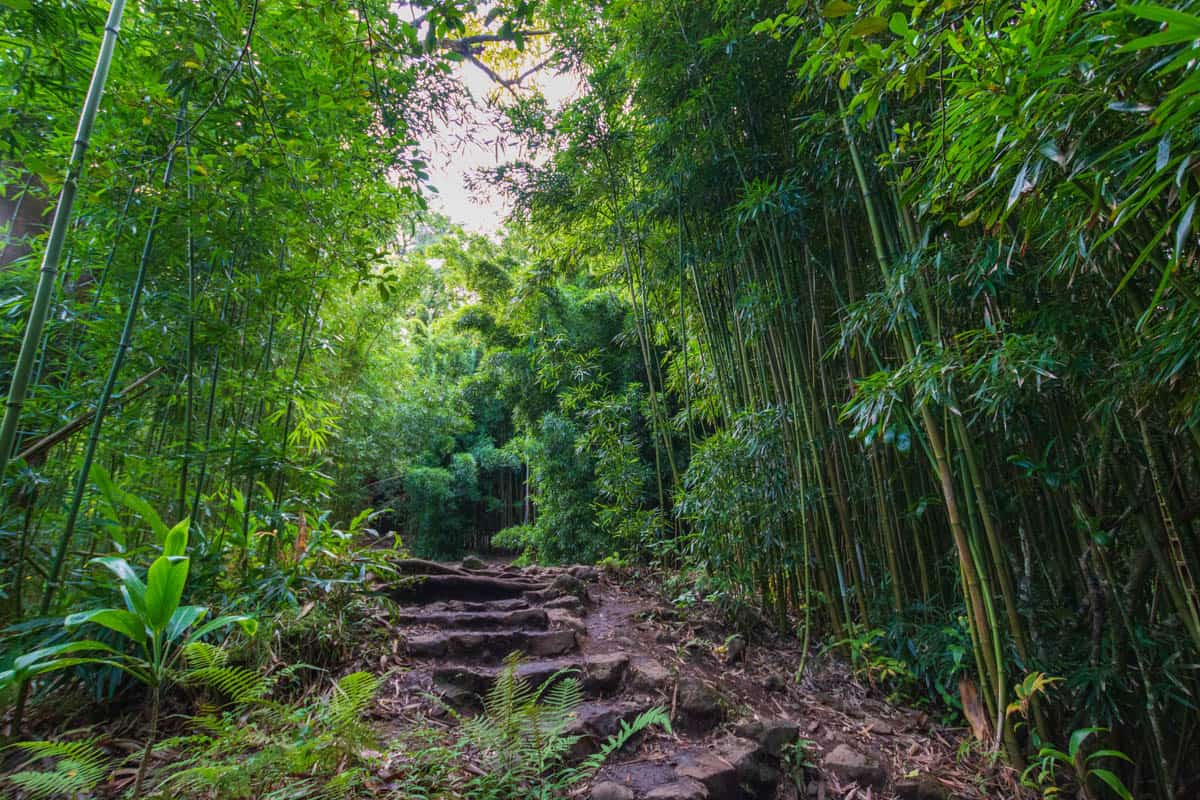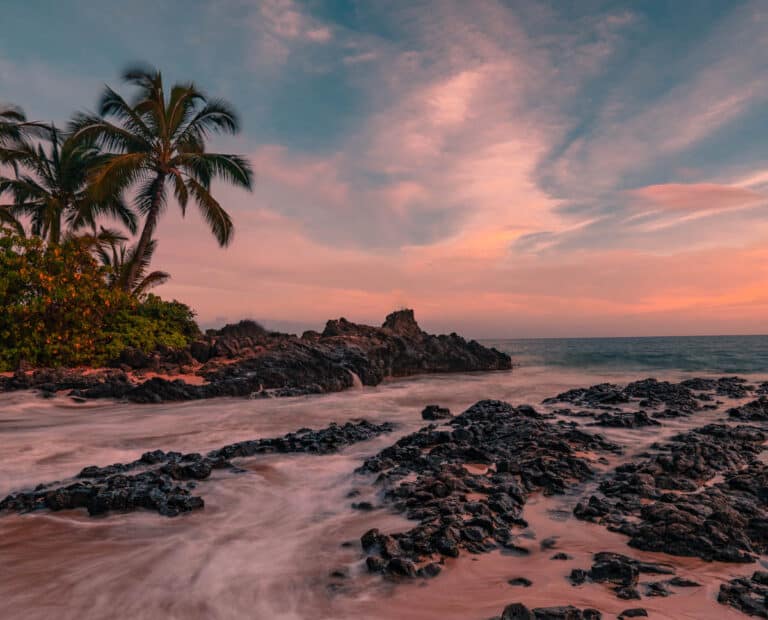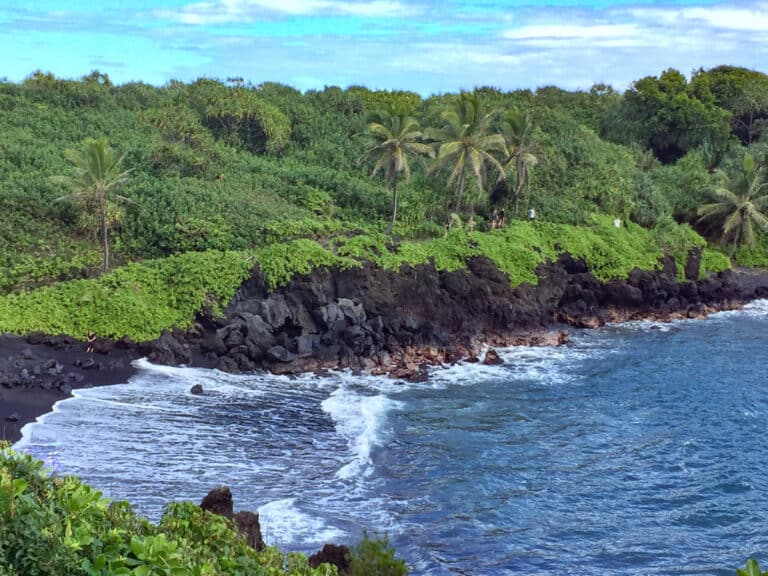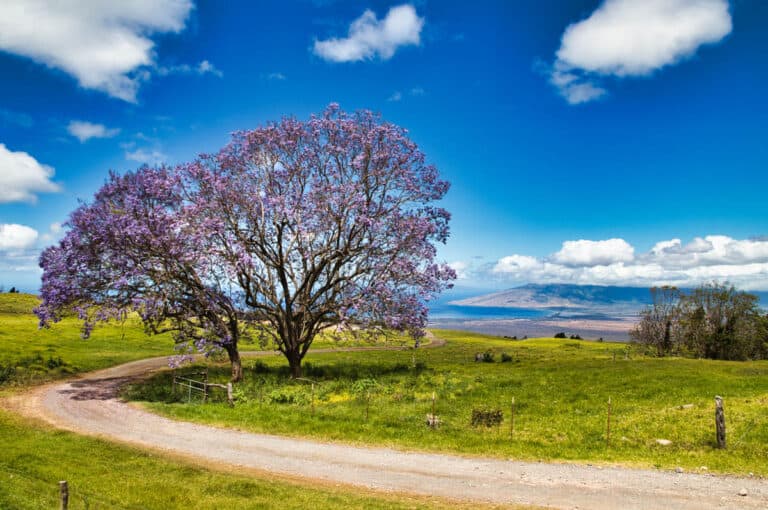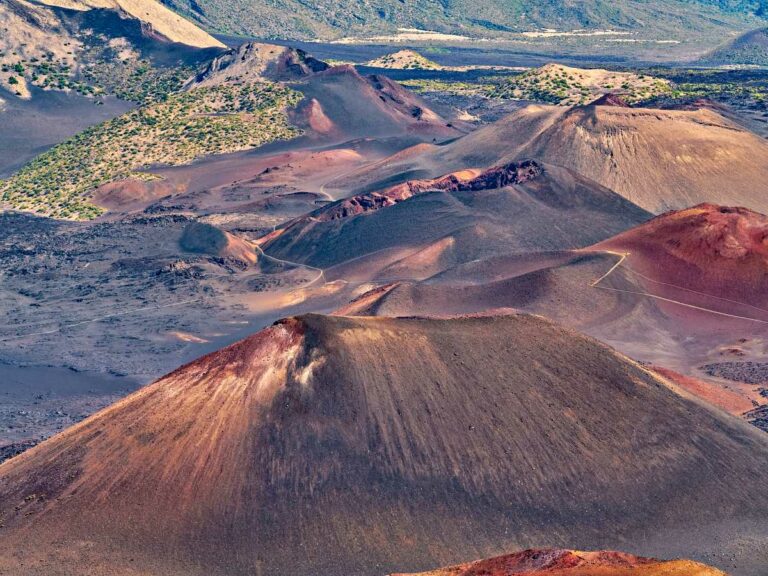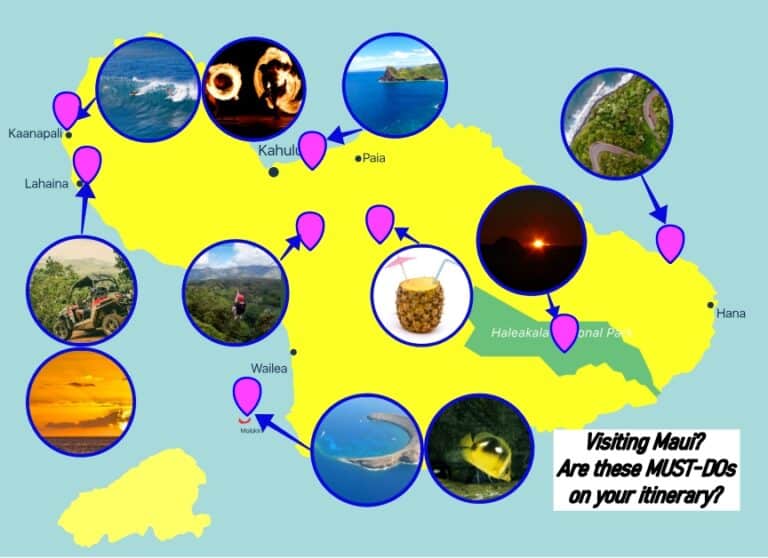Pipiwai Trail, Maui: Bamboo Forest and Waimoku Falls Hike
The Pipiwai Trail is one of the most popular hikes in Maui.
A scenic trail that winds through different types of lush tropical forests, the Pipiwai Trail is a moderately challenging hike with a great payoff.
If you are looking for the Haleakala bamboo forest hike, it’s the Pipiwai Trail!
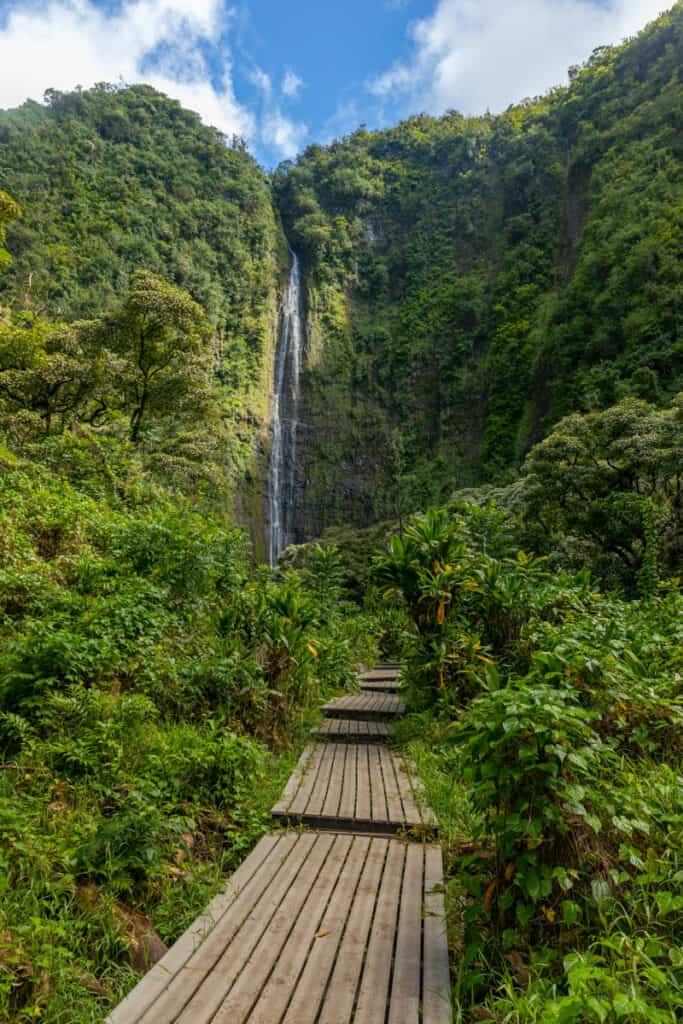
We hiked the Pipiwai Trail on our first visit to Maui. Along with the Sliding Sands Trail in the Summit District of Haleakala National Park, the Pipiwai Trail was our favorite hike in Maui.
Indeed, it may be one of our top hikes anywhere: the rainforest scenery is sensational.
Read on to discover how to hike the Pipiwai Trail, along with our tips for the best experience.
Hey, by the way! Snorkeling is probably at the top of your Maui itinerary — check out our guides to the best tours to Molokini Crater and Turtle Town, two of the top snorkel spots on Maui!
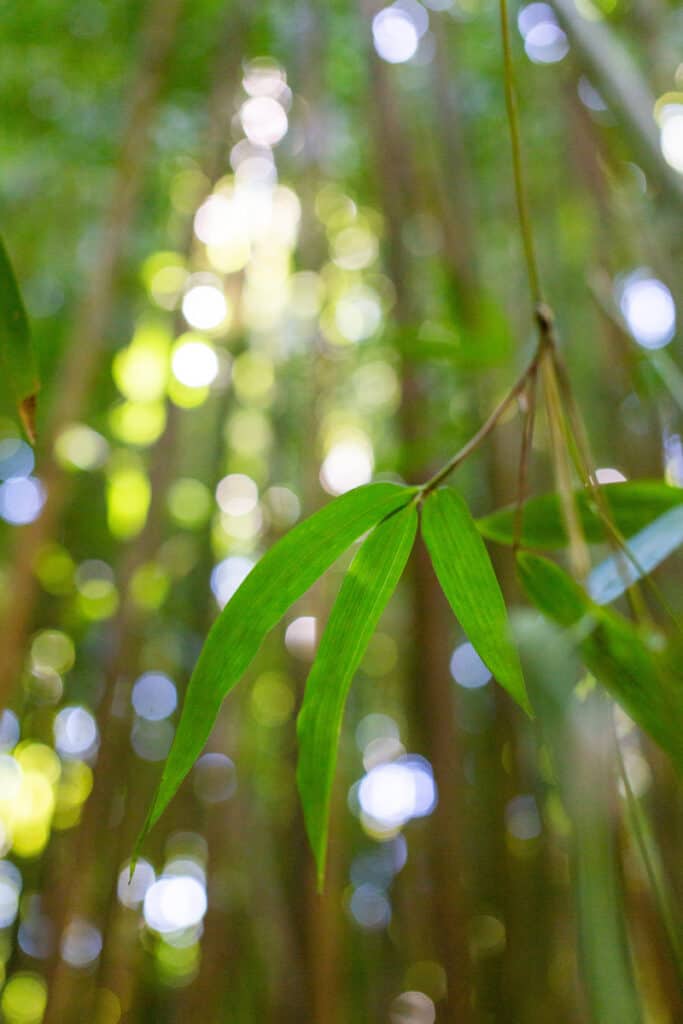
Some links on this page may be affiliate links. If you click an affiliate link and make a purchase, we may receive a small commission, at no extra cost to you. For more details, refer to our disclosure.
Pipiwai Trail, Maui: Hike Fast Facts
Length: 4 miles, out and back
Elevation change: 800 feet
Difficulty level: Moderate
Pets: Dogs not allowed on the Pipiwai Trail
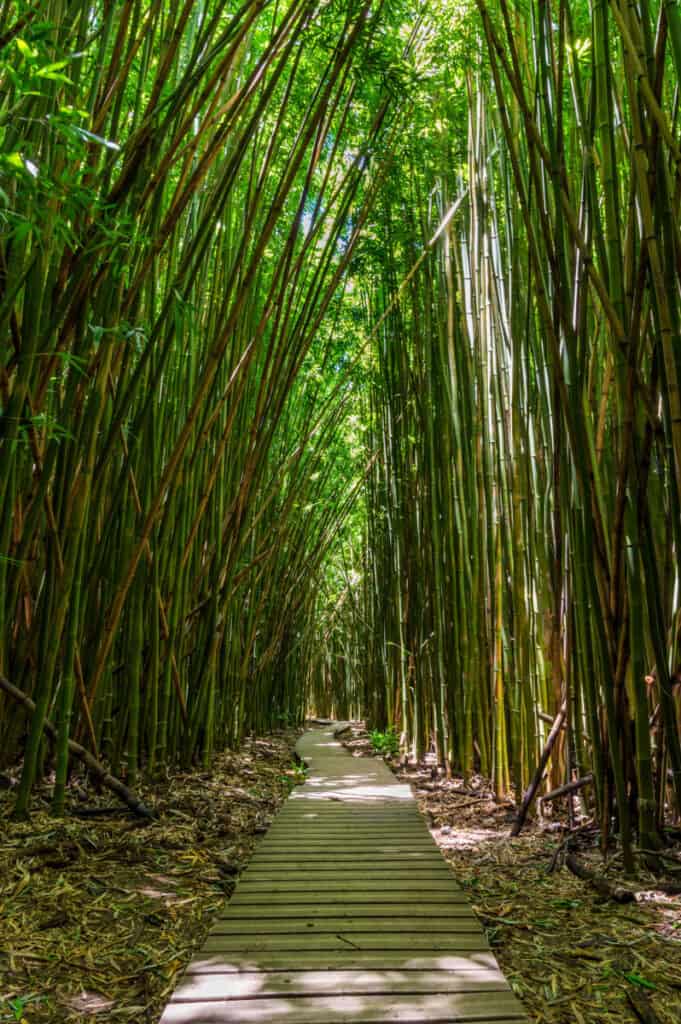
Pipiwai Trail Waterfall
The main Pipiwai Trail waterfall is Waimoku Falls. Waimoku is Hawaiian for water that breaks into two, which it often does when the flow is raging!
The Pipiwai Trail hike is also sometimes called the Waimoku Falls via Pipiwai Trail hike since this is how most people go to see the popular Waimoku Falls.
The other big Pipiwai Trail waterfall is Makahiku Falls, which you can see roughly after a half-mile hike on the Pipiwai Trail.
Note: There is a third smaller Pipiwai Trail waterfall where the Palikea stream joins the Pipiwai stream, more of a tiered cascade, just past the banyan tree and before the bamboo forest.
Pipiwai Trail Difficulty
The Pipiwai Trail difficulty is rated as moderate. You are hiking a well-maintained, popular trail with a boardwalk setting as well as sections on packed mud and some stone steps.
In my opinion, the first part of the Pipiwai Trail up to the Waimoku Falls (0.5 miles) is the most difficult part of this trail, and involves climbing steps. The rest of the trail was relatively easy.
I suspect the Pipiwai Trail is considered a moderately challenging hike because after it rains some parts of the trail become muddy and slippery. Be careful when stepping on the exposed roots and stone steps as well.
Pipiwai Trail Length
The Pipiwai Trail length is 2 miles for a round trip, out-and-back, total distance of about 4 miles.
We barely noticed the distance, there is so much to see along the way!
Pipiwai Trail Elevation Gain
The Pipiwai Trail elevation gain is about 800 feet.
You are climbing uphill on the way to the waterfall, and may be a bit challenging for beginning hikers and smaller kids.
Pipiwai Trail Hours
The Pipiwai Trail is open 24×7 (the Hakeakala National Park hours). The Kipahulu Visitor Center is open from 9:30 am to 5:00 pm, but the restrooms are open 24×7.
But who wants to hike the Pipiwai Trail in the dark? I would recommend hiking only when you have enough light to admire the beautiful scenery.
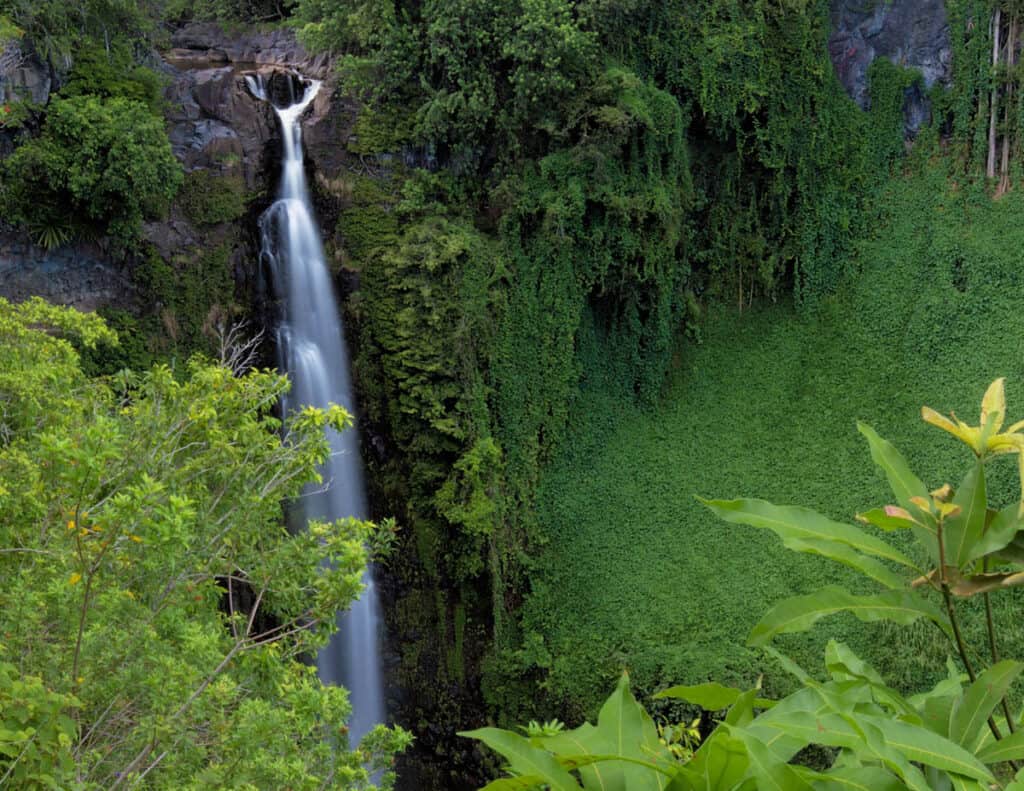
>> Book these 5-star rated, highly popular, Maui Tours now!
Getting to the Trailhead for the Pipiwai Trail Hike
Pipiwai Trail Directions
Pipiwai Trail directions are straightforward. You will find the Pipiwai Trail in the Kipahulu District of Haleakala National Park in east Maui.
You can get to the Kipahulu District of the park either via the Hana Highway or via Highway 37.
The Hana Highway is a very popular Maui attraction in its own right, with lots of stops en route to the Kipahulu District.
If you choose this route, drive a little over 10 miles past the town of Hana to the Kipahulu Visitor Center, where you can park.
The trailhead is a fairly long (and somewhat intense) drive from places along the west shore of Maui, so take drive times into account when planning your itinerary.
If your rental car agreement allows, you can also access the Kipahulu District by driving Highway 37 to the Pilani Highway along the south of the island and then up the east shore to the visitor center.
Pipiwai Trail Parking
Pipiwai Trail parking is available in the large, paved parking lot at the Kipahulu Visitor Center of Haleakala National Park.
If the paved parking lot is full, there is additional unpaved parking as well.
There is no parking fee. Pipiwai Trail parking is free with your national park entrance fee (see below).
But the Pipiwai Trail is hugely popular, so you may have to wait for a parking spot unless you arrive early in the day, or later in the afternoon.
Pipiwai Trail Reservation & Permit
You don’t need to make a Pipiwai Trail reservation or obtain a Pipiwai Trail permit to hike the trail currently.
You’ll need to pay the Haleakala National Park entrance fee to access the Pipiwai Trail.
At the time of writing, the park entrance fee is $30.00 per vehicle, valid at both the Summit District and the Kipahulu District for 3 days. You will likely need a credit card.
If you have an America the Beautiful National Parks Pass, be sure to bring it and display it in your vehicle. If you do not have a pass yet, you can buy one online at REI.
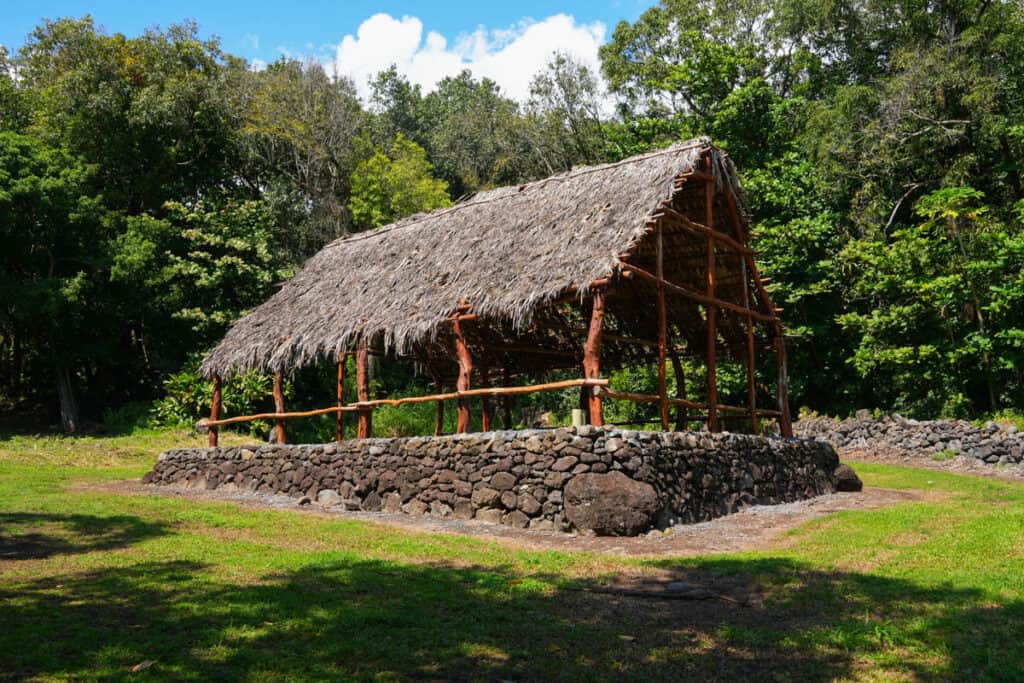
Finding the Trailhead
Once you’ve parked, it’s easy to start out on your hike.
You’ll find the signed trailhead for the Pipiwai Trail right by the Kipahulu Visitor Center of Haleakala National Park.
>> Book these 5-star rated, highly popular, Maui Tours now!
The Best Time to Hike the Pipiwai Trail, Maui
You can hike the Pipiwai Trail year round, but note that the winter months tend to be even rainier than normal in this part of Maui, so expect much of the trail to be very muddy if you hike then.
Ideally, you want to pick a bright sunny day during a dry patch, for the best trail conditions on the Pipiwai hike. Check weather conditions for Hana, the town closest to the trail.
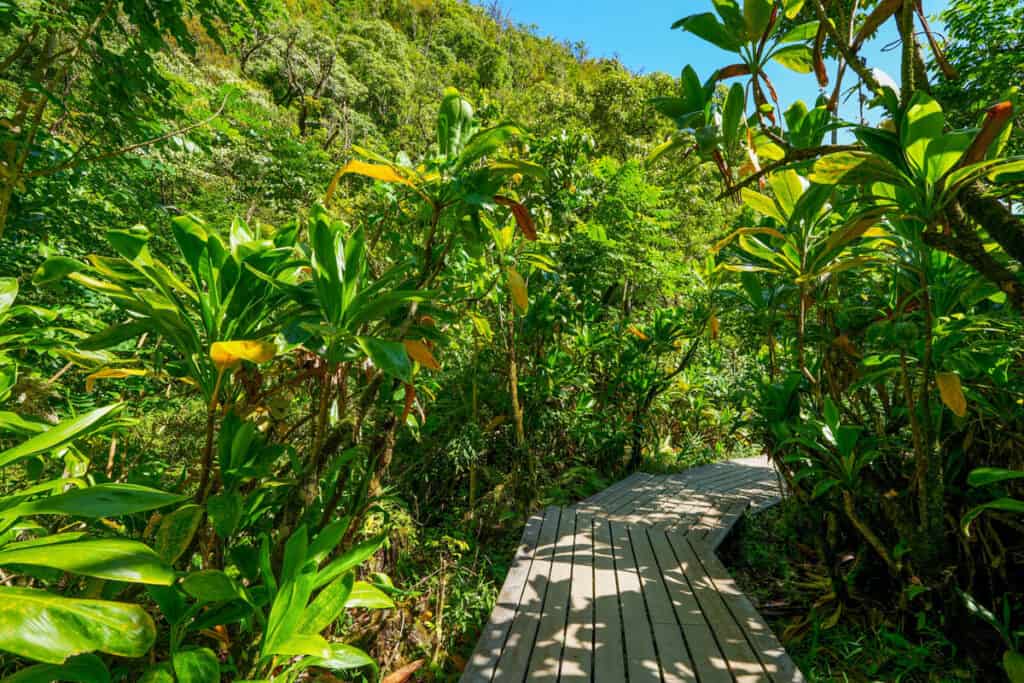
Since the Pipiwai Trail is one of the most popular hiking trails in Maui, you should plan to arrive early in the day to avoid the worst of the crowds along the trail.
You’ll also find it less hot if you start early, especially if you plan to hike the Pipiwai Trail during the summer.
How long does it take to hike the Pipiwai Trail?
Short answer: it depends.
There’s a lot to see and experience along the trail, and if you love nature and aren’t just focused on getting to the end and back, you could spend quite a bit of time enjoying nature and snapping photos.
Allow two hours at a minimum, but you can spend 4 to 5 hours along this hike if you go slow.
>> Book these 5-star rated, highly popular, Maui Tours now!
Pipiwai Trail Information
What can you expect along the Pipiwai Trail?
Some of the most spectacular natural scenery you’ll see on any hike: a variety of forests, an idyllic stream, a massive banyan tree, a boardwalk through a tunnel of bamboo, waterfalls, and more!
You’ll start the hike with a climb up the ridge beside the Palikea Stream that can be rather muddy and slippery at times, so watch your step.
Below we’ve described some of the highlights you’ll encounter on the Pipiwai Trail, but we found most of the trail fascinating!
Makahiku Falls Viewpoint
Just about one half of a mile into the hike, you’ll see the Makahiku Falls tumbling 200 feet down a cliff face, disappearing into the tropical vegetation below.
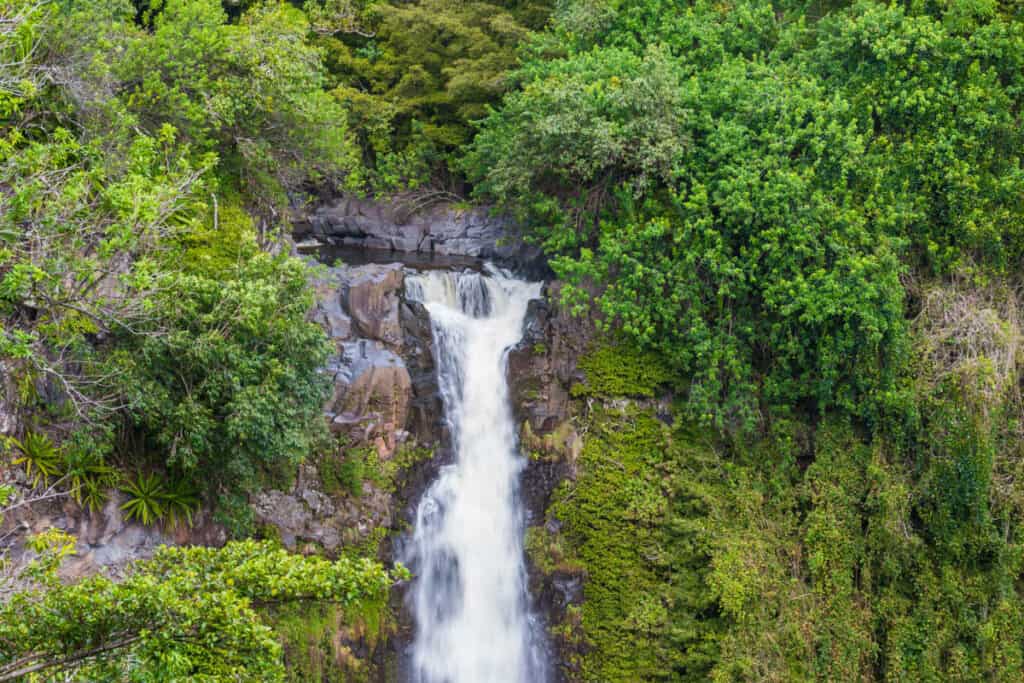
These thundering falls are framed by giant-leaved vines, ferns, bamboo, and other tropical plants.
The flow is much more powerful if it’s rained recently, but regardless, this is a great place to take some photos!
The Pipiwai Banyan Tree
Next you’ll come to the Pipiwai banyan tree, a large specimen that’s several decades old.
The banyan tree is known for its aerial roots that originate in its branches and eventually drop down to the earth to form secondary trunks.
It’s a very cool tree!
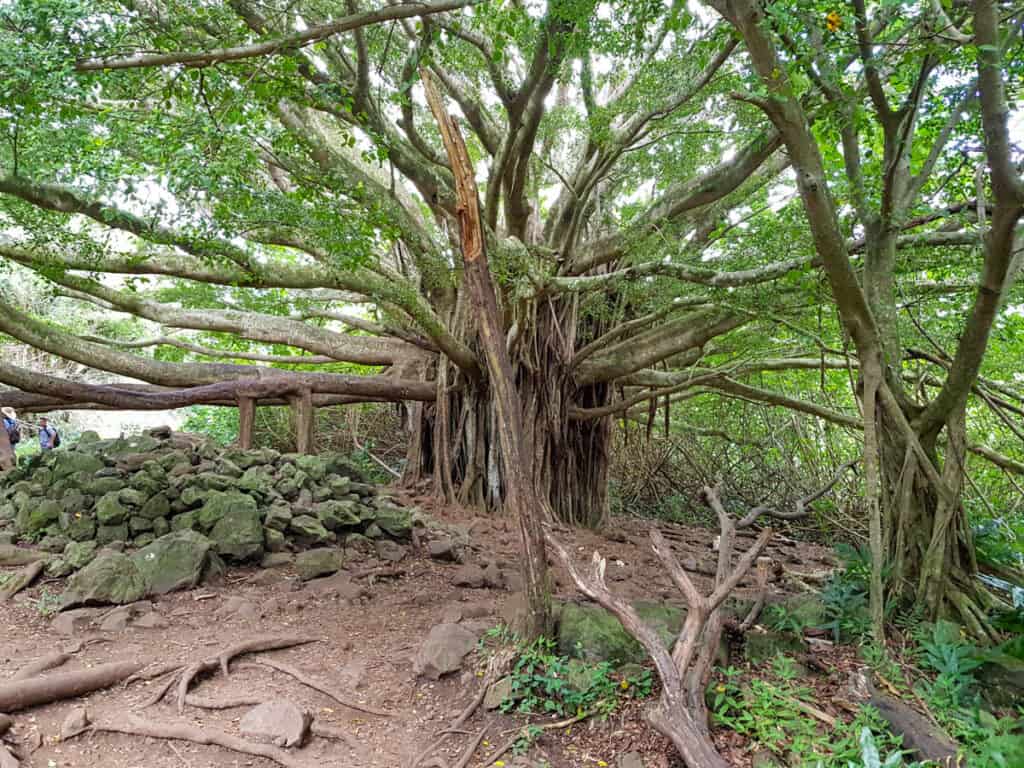
While not as spread out as the gigantic Lahaina Banyan, the Pipiwai banyan tree is still very impressive. Its spread is the size of a good-sized house.
Climb up the tree if you like, to pose for a photo, or admire it from below.
The Haleakala Bamboo Forest on the Pipiwai Trail
One of the top reasons visitors put the Pipiwai Trail on their Maui bucket list in the opportunity to walk through a bamboo forest.
You’ll come to the bamboo forest about one mile into the hike.
Right before the bamboo forest is a bridge that’s perfect for photos.
In parts, the trail through the bamboo forest is boardwalk, and there are footbridges across muddy sections.
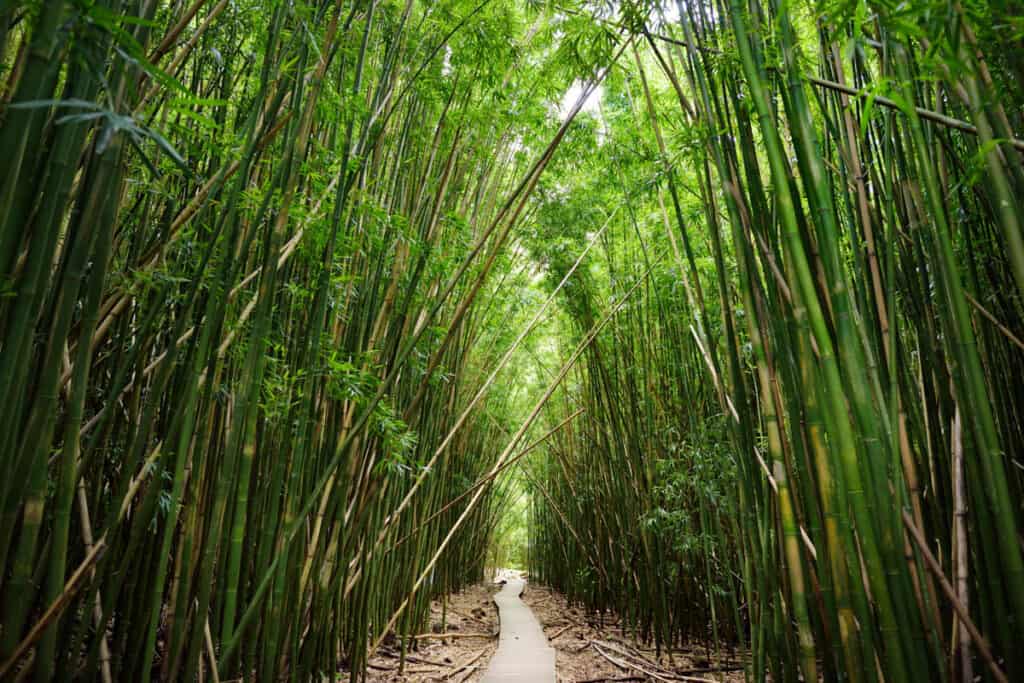
As you walk, awe struck, through the tall bamboo tunnel, listen for the sound of bamboo stalks hitting up against one another as they sway in the breeze.
The hollow clacking sounds like giant wind chimes!
The hike through the bamboo forest is about one half of a mile.
Waimoku Falls via Pipiwai Trail
As you make your way out of the bamboo forest, you’ll start to see other types of vegetation, and hear the distant thunder of water.
Here’s where you get your first glimpses of Waimoku Falls, one of the tallest waterfalls in Maui.
If you are here in the summer, look for the grove of mountain apples that comes up right as the bamboo begins to thin. The red fruit make for a refreshing treat.
Hike up the boardwalk trail to the viewing area for a full-on view!
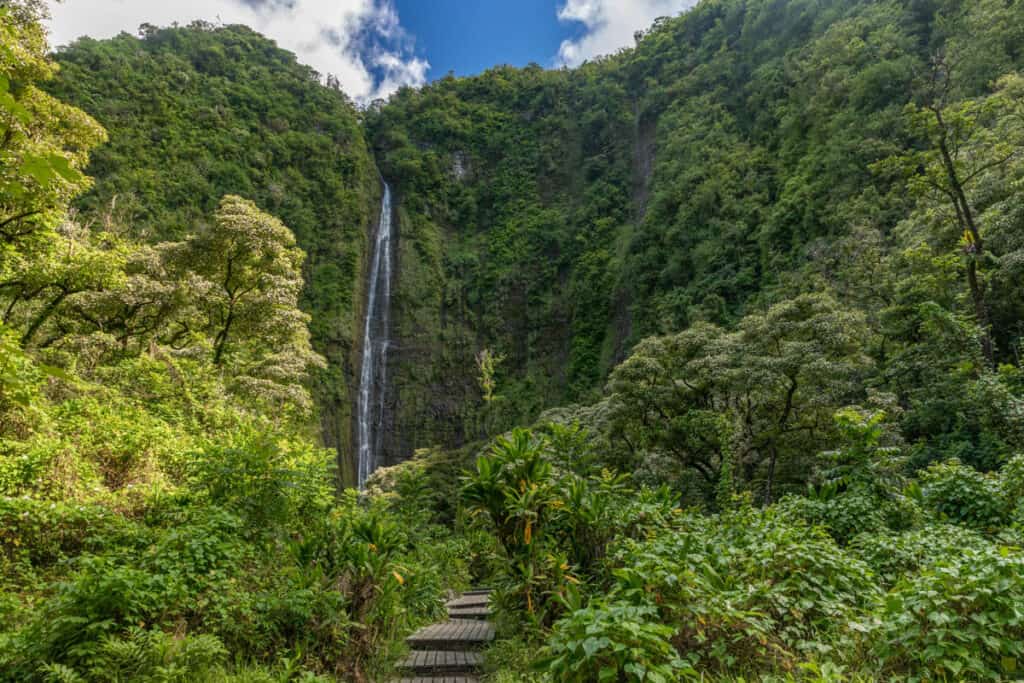
The waterfall plunges 400 feet down a lava rock wall and offers a jaw-dropping sight, especially when the flow if full.
It’s framed by lush tropical greenery, making for the perfect Hawaii photo.
If it’s rained in the days prior to your visit, you’ll see a weeping wall phenomenon, with other cascades around the main waterfall!
Note: To get to the point closest to the waterfall, you have to cross a stream and scramble over some rocks.
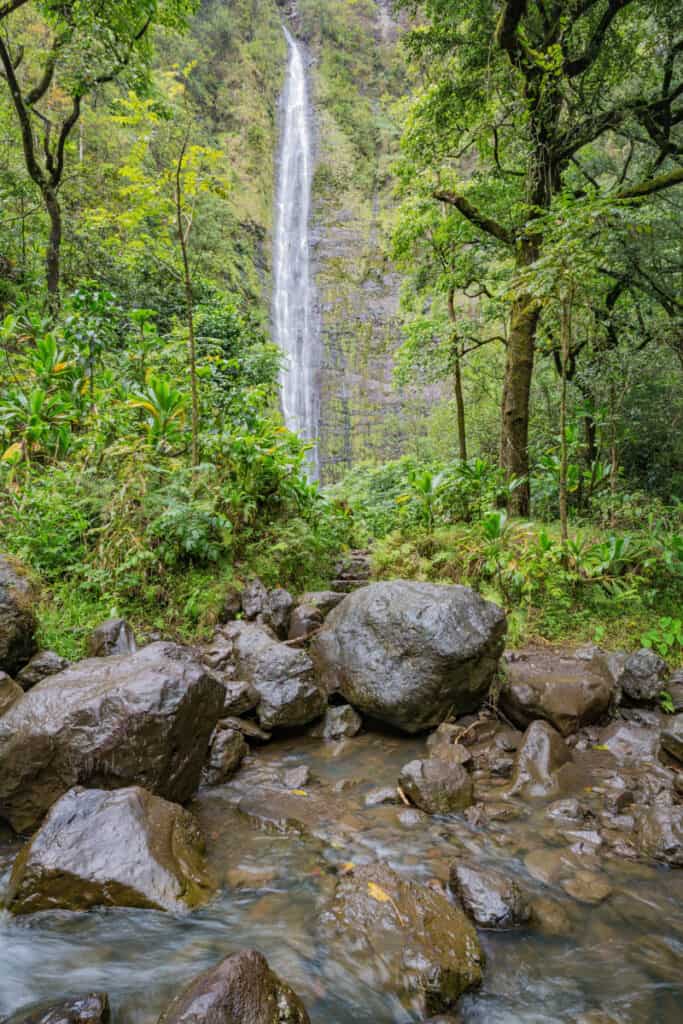
But the views before the stream crossing are excellent, so you do not have to go to the very end.
And even from a distance, you’ll feel refreshed by the cool misty breeze from the falls.
There’s a sign at the official end of the trail warning you not to go any further. Heed the sign!
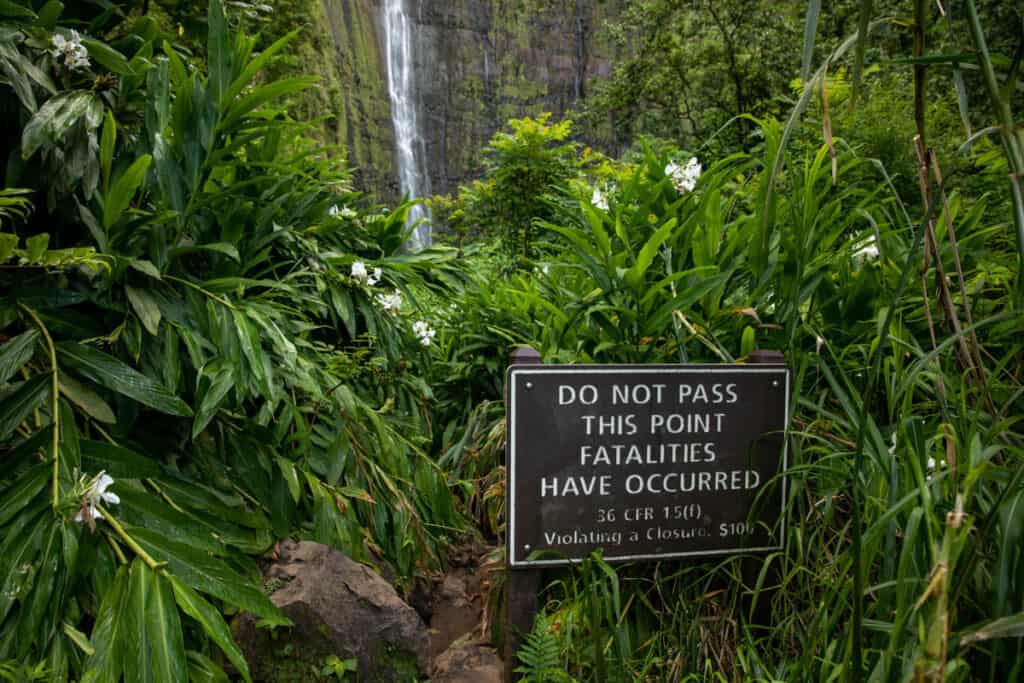
Returning to the Trailhead
After you’ve had your fill of viewing Waimoku Falls, turn around and retrace your steps to the trailhead.
The return journey is steady downhill, much easier than the way up.
Add on the hike to the Seven Sacred Pools
If you have the time and the energy, you can continue on the Kuloa Point Loop Trail, one of the easy Maui waterfall hikes, out to the shore of the ocean.
Here you’ll find the picturesque Seven Sacred Pools and the tiered waterfalls, right at the ocean.
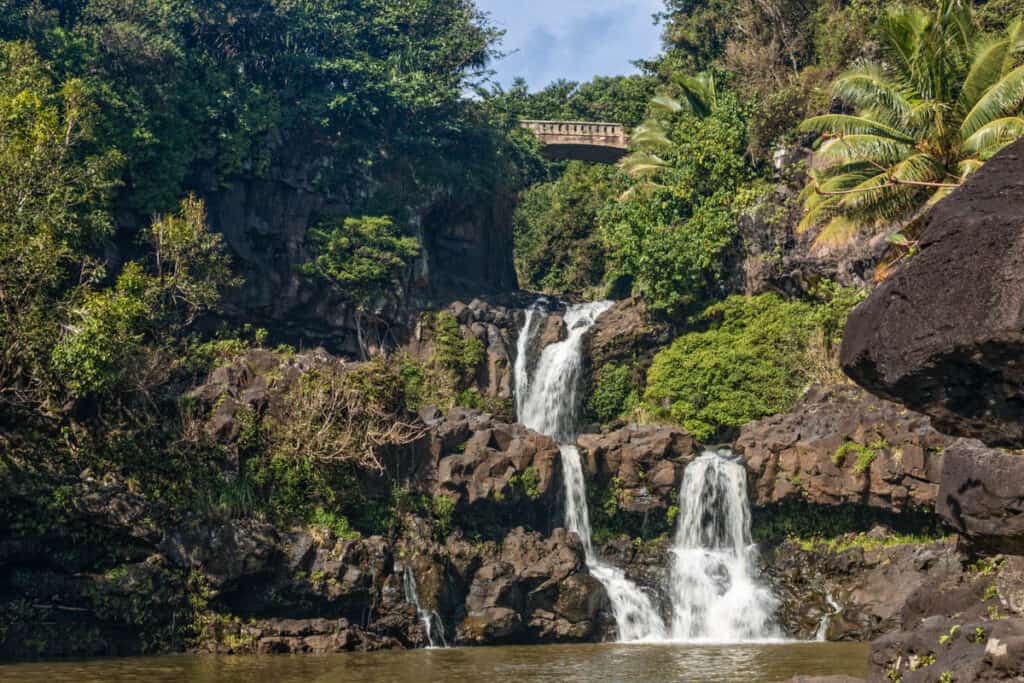
This trail is about one half of a mile loop and also features a banyan tree, albeit smaller.
Pipiwai Trail Map
The Pipiwai Trail map below shows the locations of the places mentioned above.
Hawaiian Birds to Spot on the Pipiwai Trail Hike
Make sure you take a good pair of binoculars with you, the Pipiwai Trail hike is an excellent hike to spot some beautiful Hawaiian birds, both introduced to the islands and some endemic birds (found nowhere else)!
Some of the common Hawaiian birds you can expect to spot on the hike are the Chinese Hwamei, a secretive brown bird, and you’re more likely to hear its beautiful, long song; the scaly-breasted munia, a small songbird with distinctive chest scales and its close relative, the chestnut munia; and, the warbling white eye (with a characteristic white ring around its eyes).
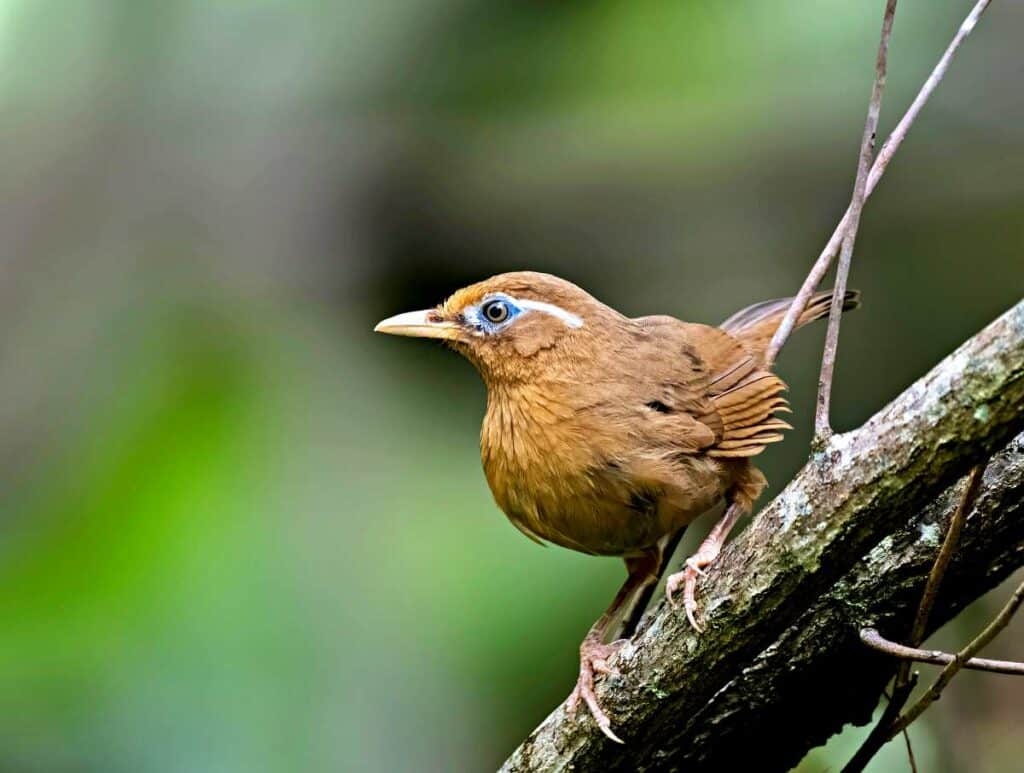
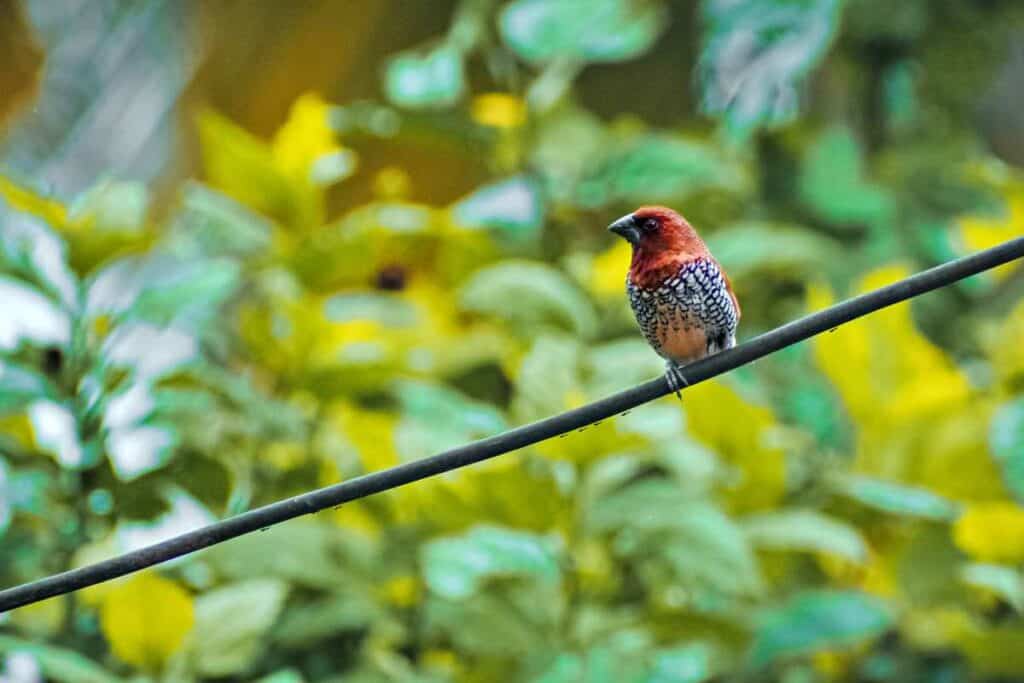
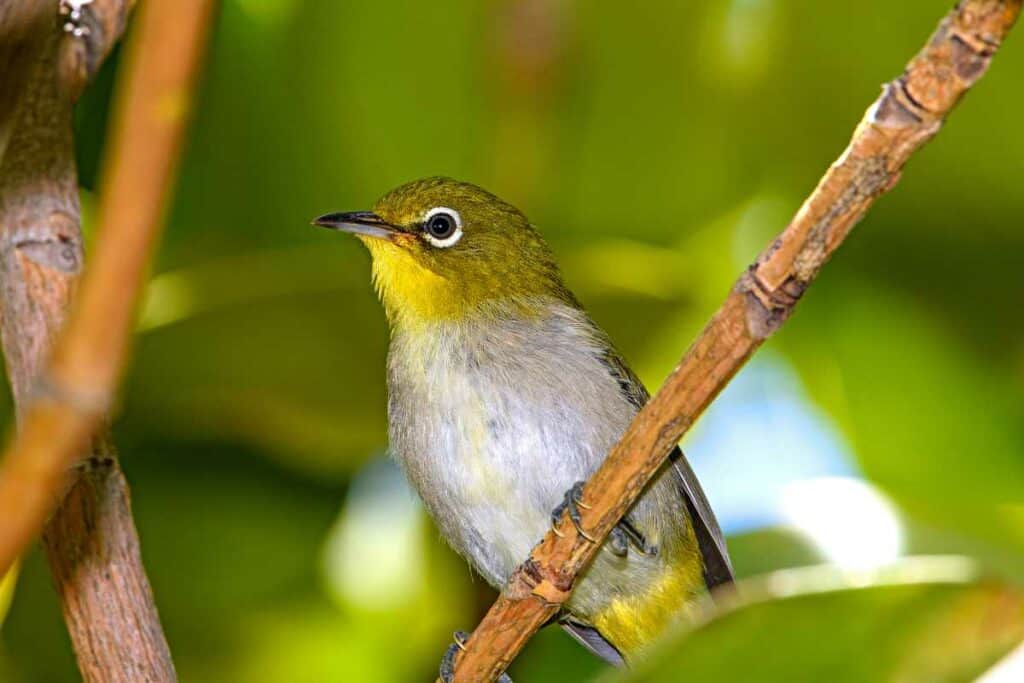
If you continue the hike to the Ohe’o Gulch, along the oceanside, you’ll see some of the common Hawaiian seabirds, including the Great Frigatebird and the red-footed booby.
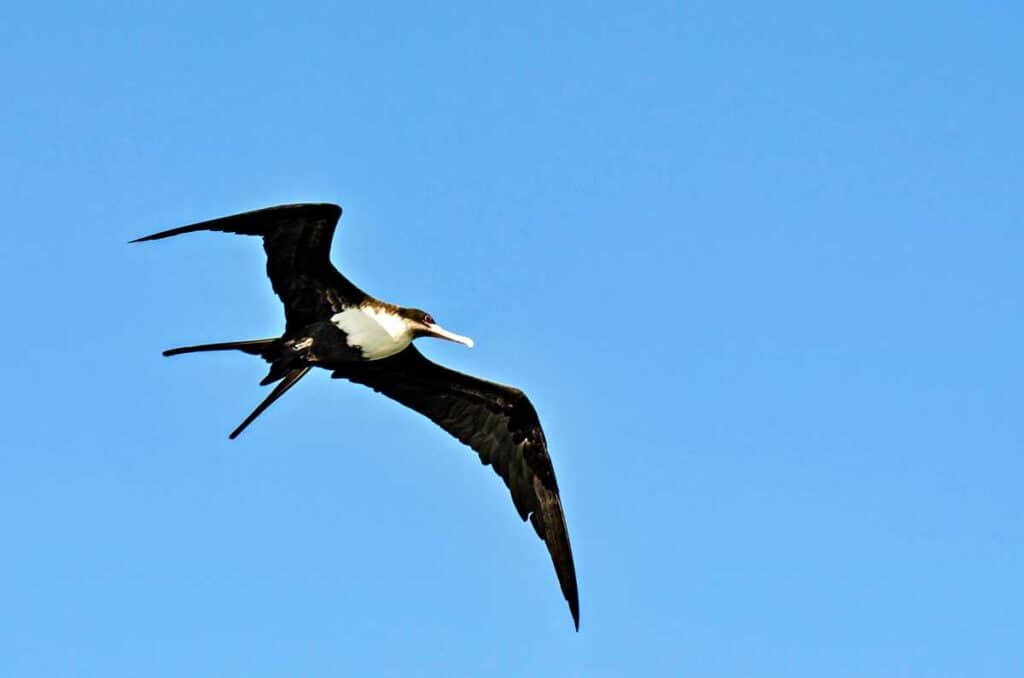
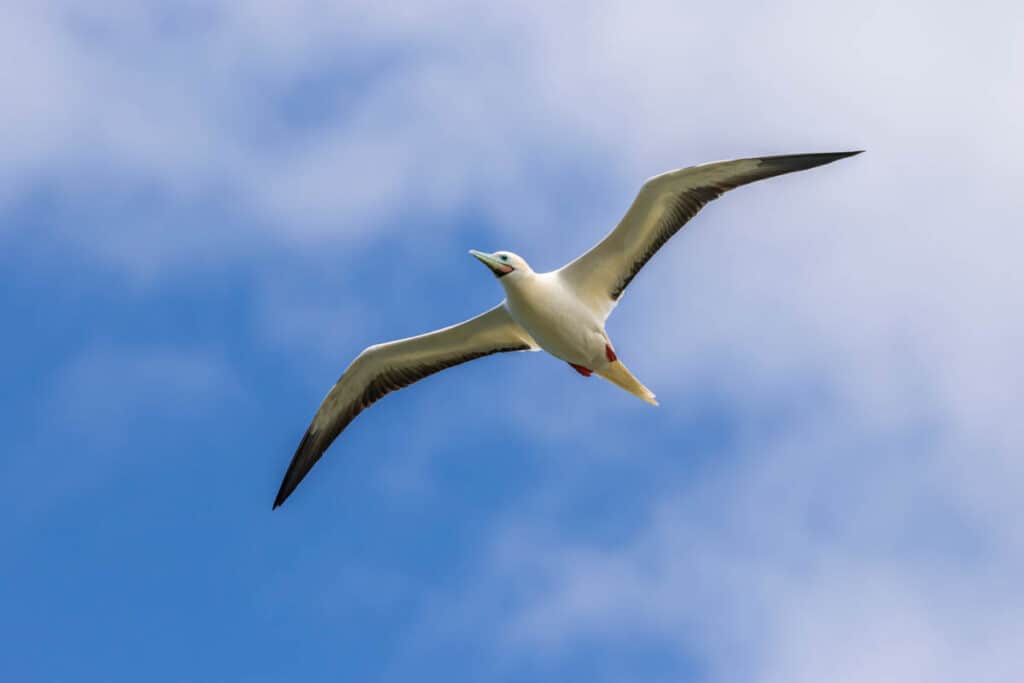
Refer to our detailed post on Hawaiian birds to identify and learn about these bird species, some endemic to Hawaii, and found nowhere else on the world!
What to Bring on Your Pipiwai Trail Hike
Sunscreen: Much of the Pipiwai Trail is shaded, but you’ll still want to use sunscreen.
Bug Repellent: You’re going to be hiking through tropical forests, so do not forget bug repellent.
Drinking Water: Bring an adequate supply of drinking water. The trail can get warm and humid.
Snacks and Food: There is no food available in Haleakala National Park. Carry a supply of snacks so you can stay fueled on your hike, and bring a picnic if you plan to have a meal here.
Charged Smartphone: This trail is so insanely scenic that you will want to stop every few feet to snap photos.
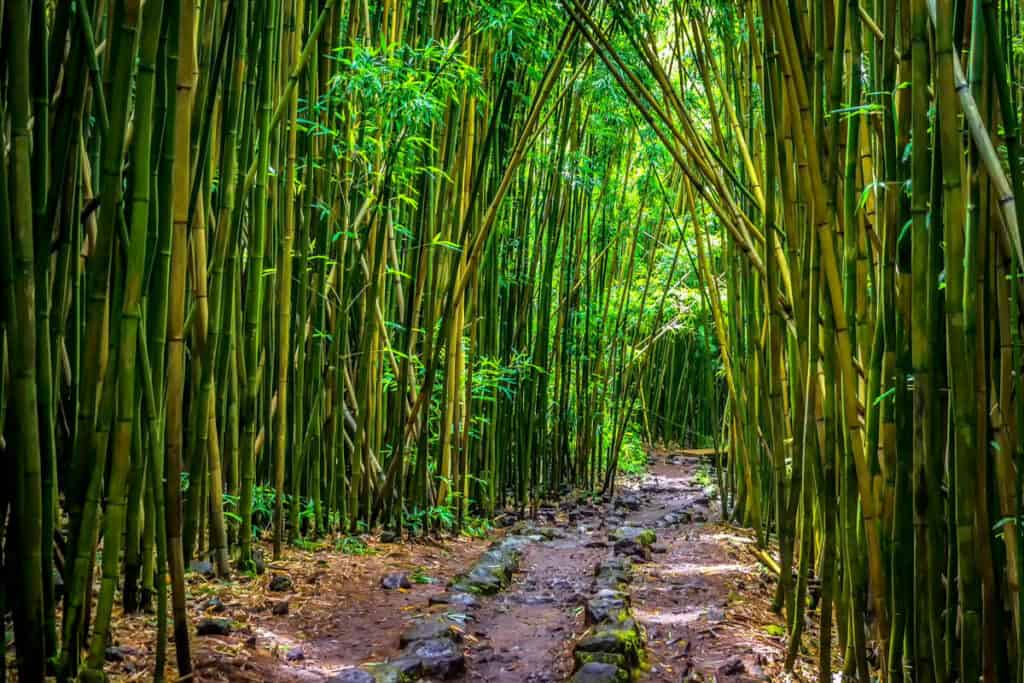
Hiking Gear Checklist
Many of Hawaii’s hikes are demanding, make sure you are well equipped and well prepared. Here’s what we typically take with us:
- Water Bottle: I hate plastic bottles, and with opaque bladders you can’t see if it is moldy inside. We use this Hydro Flask water bottle – light, stainless steel, wide mouth (you can add ice), with double-wall vacuum insulation (greatly refreshing for hikes in summer). You can also get it with a Flex Straw Lid!
- Hiking Shoes: My preferred hiking shoes are the medium range Merrell Moab 3 Waterproof Hiking Shoe (men’s, women’s, men’s mid), great for Hawaii’s trails through mud and streams. My wife loves her high-end Salomon X Ultra 4 GTX Hiking shoes (men’s, women’s), also waterproof.
- Sunscreen: Hawaii’s sun can be harsh. Avoid sunburn with sunscreen compliant with Hawaii’s 104 Reef Act. The Sun Bum Original SPF 50 Sunscreen Spray, moisturizing with Vitamin E, is our go-to when we travel to Hawaii. Apply liberally and regularly!
- Trekking Poles: Great for hikes that involve climbing, both going uphill and downhill, and on trails that are wet, muddy and slippery! Improve your footing with this collapsible, high-end Black Diamond Trail Cork Trekking Poles, available for men and women.
- Headlamp: Planning a sunrise or sunset hike? Hiking in the dark is no fun, especially on many of Hawaii’s rainforest or ridge hikes. We love these two headlamps: the budget Black Diamond Spot 400 Headlamp and the premium Petzl Actik Core Headlamp, with many features.
Tips for Hiking the Pipiwai Trail, Maui
Heed all trail warnings and closure signs
Please do not be that park visitor that pays no heed trail signs. Lives have been lost here.
Haleakala National Park has a page on safety. Be sure to read it before you visit!
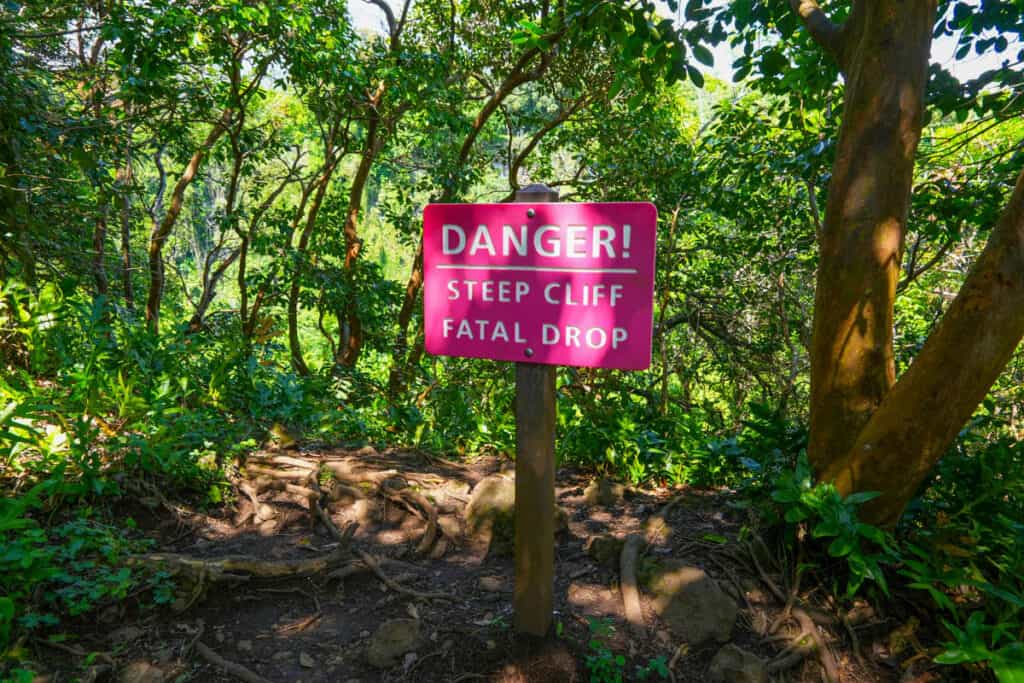
Start the Pipiwai Trail hike early in the day
The Pipiwai Trail is very popular and on most days you can expect a steady stream of hikers on the trail.
Your best shot at a more serene experience is arriving here early in the day.
Note that drive times from the west shore to the Kipahulu Visitor Center are long, so if you plan to do the scenic drive and the hike in one day, you will have to limit the stops along the Road to Hana drive.
Here are approximate drive times from popular places along the west shore, assuming normal traffic and no stops along the way:
Kapalua: 3 hours and 30 minutes
Lahaina: 3 hours and 10 minutes
Kihei: 2 hours and 50 minutes
Wailea: 3 hours
Traffic jams along the Hana Highway are common, so it’s very likely you will take longer to get to the trailhead.
If you start the Pipiwai Trail later in the day, make sure you have enough time to get back to the parking lot and out of the park by closing time: the gates are sometimes locked in the evening at 5 p.m., when the visitor center closes.
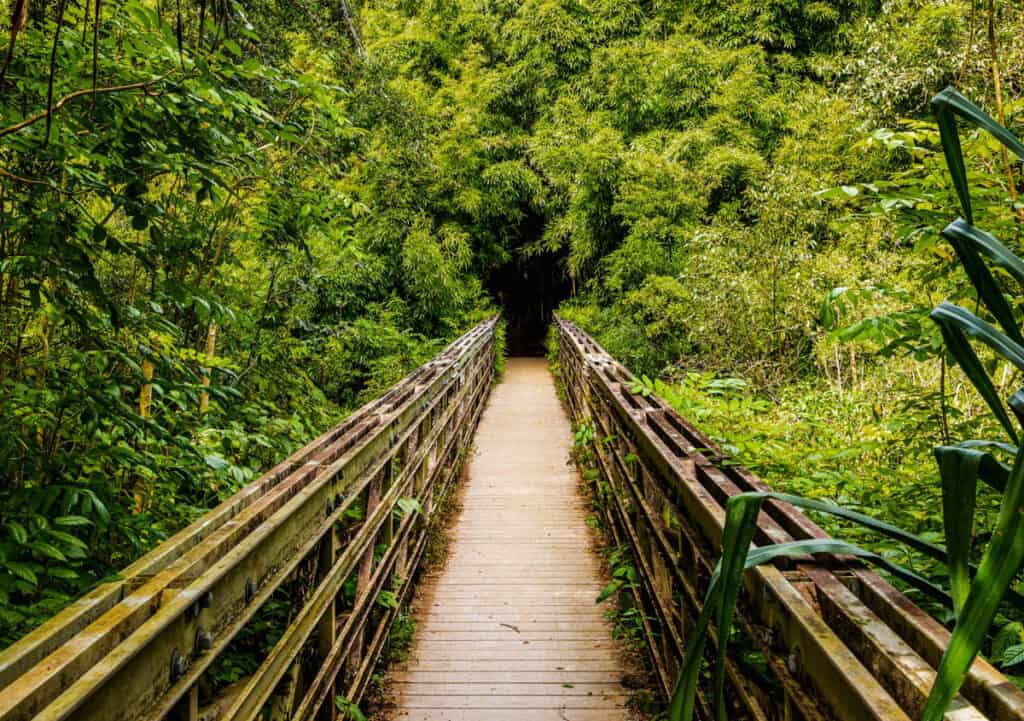
Overnight in Hana Town
Both the Road to Hana and the Pipiwai Trail are among the top attractions in Maui, and cramming both into a single day isn’t the best idea.
For a more relaxed experience, plan to overnight in Hana.
That way, you can drive to Hana on one day, enjoying the stops along the way, and arrive at the trailhead for the Pipiwai hike bright and early the following day.
After your hike, you can spend some time at a black sand beach around Hana if you like, or explore Hana Town, before you return to the west shore.
Allow plenty of time
While the trail is classed as moderate, there are some steep uphill sections, and the trail can be muddy and slick in parts.
You’ll want to give yourself enough time to walk to Waimoku Falls (or as much of the trail as you plan to walk) and back in less than ideal trail conditions.
Plus, the main reason for hiking the Pipiwai Trail is to enjoy the stunning scenery all around you. You’ll almost certainly want to stop along the way to take in views, observe the flora, and snap photos.
Don’t expect cell reception
Cell reception in the Kipahulu District of Haleakala National Park can be iffy to non-existent. Download any maps or brochures you need prior to getting here.
Note that dogs aren’t allowed
Leave your pooch behind when you visit the Kipahulu District of Haleakala National Park, because dogs are not allowed on the trails here, including the Pipiwai Trail.
Fill up your gas tank
There is no gas available in Haleakala National Park, so make sure to fill up in Hana Town if you need gas.
Dress appropriately
Check weather conditions prior to setting out on the Pipiwai Trail, so you can bring a waterproof jacket if rain is in the forecast.
Otherwise, wear comfortable clothing that won’t stick to you when it’s warm and humid. Long sleeves and long pants are helpful both against bugs and the sun.
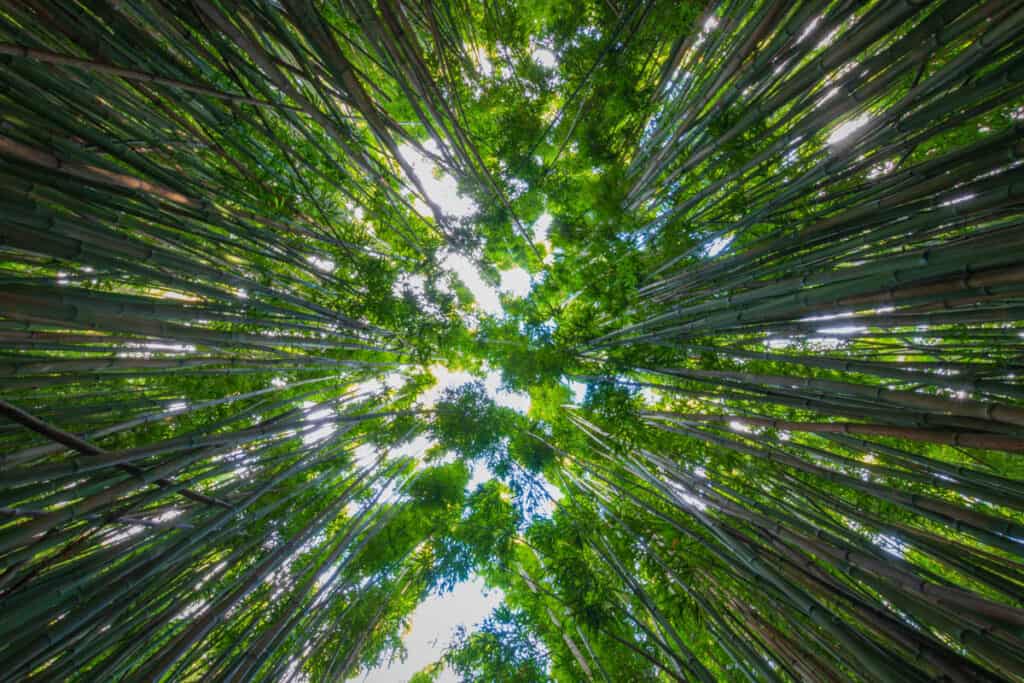
Wear proper shoes
The trail is well maintained but can be very muddy, and slick in places. There are tree roots and loose rocks on the trail as well.
Wear sturdy closed-toed shoes with good grip.
Don’t forget your National Parks Pass
Entrance to Haleakala National Park (and the Pipiwai Trail) is included in the National Parks Pass. Don’t forget to bring your pass if you have one.
If you do not have one, an annual pass may save you money if you plan to visit 2-3 federally managed recreation areas over the year.
Buy your National Parks pass online at REI!
Frequently Asked Questions
1. Does the Pipiwai Trail require reservations?
The Pipiwai Trail currently does not require reservations. However, the trail is popular, so arrive early in the day to beat the crowds and find parking easily. Or hike later in the day.
2. How difficult is the Pipiwai Trail?
The Pipiwai Trail is classed as moderately challenging, mainly because the trail is uphill, gaining about 800 feet in elevation. It is also a long-ish hike, at about 4 miles round trip.
3. Is the Pipiwai Trail worth it?
Yes, absolutely! The Pipiwai Trail is one of the most popular hikes in Maui because it is so scenic and family-friendly. It features a bamboo forest, waterfalls, a large banyan tree, and lush tropical vegetation.
4. How should I dress for the Pipiwai Trail?
Wear light-colored comfortable clothing to stay cool. Long pants and long sleeves will help protect from the sun and bugs. Wear closed-toed waterproof walking shoes that you don’t mind getting muddy. Use sun protection and bug spray.
5. Should I hike the Pipiwai Trail in the morning or the afternoon?
Either early in the morning or late in the afternoon is a good time to hike the Pipiwai Trail, because parking is relatively easier to find at these times. Arrive at opening time to hike it in the morning, and by 2.30 p.m. or so to hike it in the afternoon: you want to finish before the park gate closes.
6. Is the Pipiwai Trail the same as bamboo forest?
A bamboo forest is part of the landscape you hike through on the Pipiwai Trail. The forest is dense, with tall bamboo, and the trail is boardwalk, for a stunning experience.
7. How many waterfalls do you see on the Pipiwai Trail?
While the 400-foot Waimoku Falls is the ultimate payoff on the Pipiwai Trail in Maui, along the way you are also treated to views of the Makahiku Falls.
8. Can you swim in waterfalls on the Pipiwai Trail?
While the two waterfalls along the Pipiwai Trail are stunning, they are best viewed from the trail or the designated viewing areas on the trail.
You will likely see folks standing at the bottom of the falls, but there is a serious risk of falling boulders, so heed the sign!
The Best Maui Tours
Have you booked these top-rated Maui guided adventures yet?
Small-group Road to Hana tour so everyone in your group can sit back and enjoy the views without worrying about negotiating hairpin bends or finding parking at popular stops!
A Haleakala sunrise tour so you can experience the bucket-list sunrise atop the volcano without the need to reserve a parking spot or drive up in the dark!
A Maui whale watching raft tour, which will let you see the massive humpback whales at eye level! (You can also opt for a more sedate boat whale watching tour.) A MUST winter Maui activity!
A Maui snorkeling excursion that combines the Molokini Crater with Turtle Town, the two most epic snorkeling destinations on the island!
A 7-line Maui zipline experience where you can glide over the forests on the north shore of Maui. Enjoy ocean views and navigate obstacle course challenges!
An oceanfront luau in Wailea where you can enjoy a sunset buffet and traditional Polynesian entertainment. You can also opt for a Kaanapali oceanfront luau.
Renting a Car in Maui
The best things to do in Maui are located all over the island.
Public transport options on Maui are minimal to non-existent, so if you want to explore the island beyond your base, you’ll want to book a rental car for your Maui trip.
We always use Discover Cars to book Maui car rentals. They search across a variety of rental car companies, both budget and brand, to offer you the best deals, AND they offer free cancellations. Plus, there are no hidden fees.
>> Check availability and prices on Maui car rentals now!
Where to Stay in Maui
Depending on whether you want a vacation rental with more room and the option to cook some of your meals, or you want a resort or hotel experience, and depending on which part of Maui you want to choose as your base, you have a variety of options.
By far the majority of visitors to Maui choose to base on the west side, where there is a large selection of accommodations available, from resorts and hotels to vacation rentals.
We suggest starting your search for Maui accommodations by browsing vacation rentals on VRBO. You can filter to choose a specific area, such as Kihei, Kapalua, or Wailea.
We have stayed in VRBO rentals in Kihei and Kapalua and find that the choice and quality are generally great.
>> Look for a Maui vacation rental on VRBO now!
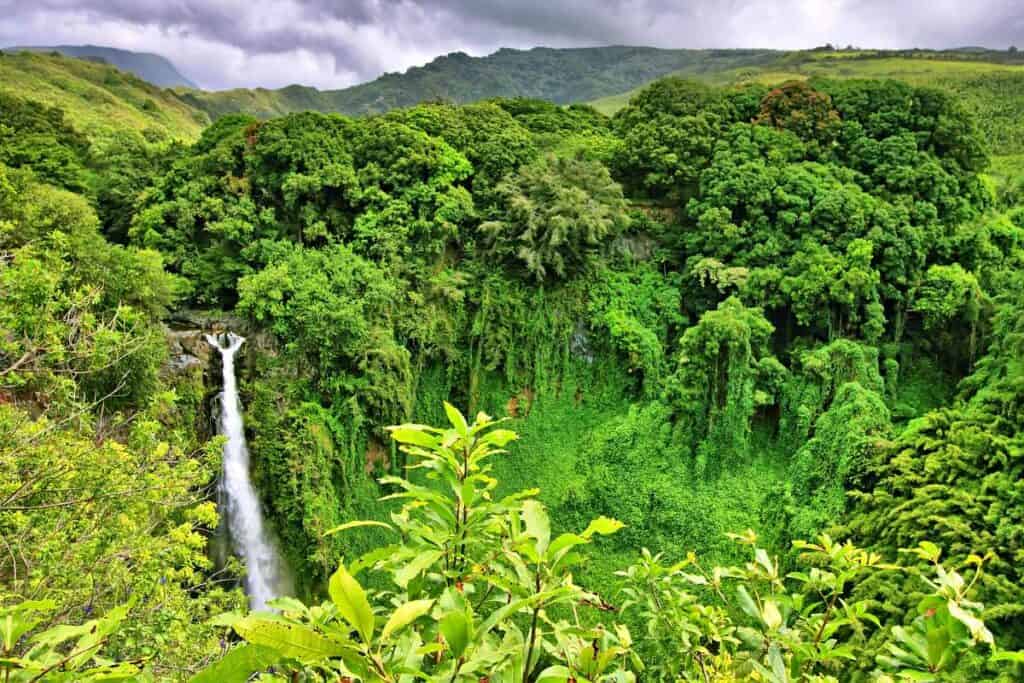
More Maui Travel Inspiration
If you are considering a trip to Maui, read some of our other comprehensive guides to craft the ultimate Maui itinerary!
If you are a first-time visitor to Maui, start by reading our article on the best things to do in Maui. From beautiful beaches and lush rainforest to Maui’s volcanic crater, our round-up captures the most iconic Maui experiences and activities.
If you are dreaming of a winter getaway to a tropical paradise, read our guide on why you should visit Maui in winter!
If you are planning a brief first visit to Maui, here’s our 3-day Maui itinerary to help you flesh out your own trip! And if you are considering a couples getaway to Maui, read about the top romantic things to do in Maui!
Driving the Road to Hana is one of Maui’s bucket-list experiences. We have a comprehensive guide to the best stops on the Road to Hana, including waterfalls and short hikes on the way.
One of the top stops on the route is Wai’anapanapa State Park, which requires reservations. Read our full guide to Maui’s black sand beach in this popular state park!
Maui boasts one of only two national parks in Hawaii. Read our round-up of the best things to do in Haleakala National Park. We also have the ultimate guide to sunrise at Haleakala.
We also have a guide to the best hikes in Haleakala National Park, and in-depth hiking guides to the two most epic hikes in the park: the Sliding Sands Trail and the Pipiwai Trail.
Speaking of hiking, also be sure to check out our round-up of the best Maui hikes, from easy to challenging. Plus, peruse our complete guides to hiking the popular Kapalua Coastal Trail in northwest Maui, and the Waihee Ridge Trail for astounding views!
We also have a round-up of the best waterfalls in Maui, from the 400-foot Waimoku Falls to Upper Waikani Falls near Hana. Some Maui waterfalls can be seen from viewpoints whereas others require hiking.
Water activities are plentiful in Maui! Check out our epic guide to whale watching in Maui, and our guide to the best Molokini snorkeling tours and the best Turtle Town snorkeling.
If you’d rather snorkel from shore, read our round-up of the best snorkel spots in West Maui.
Every Maui itinerary should have plenty of beach time: there are so many beautiful beaches in Maui that you are spoiled for choice. We have a round-up of the best beaches in South Maui, plus a detailed guide to Wailea Beach in southwest Maui, and one for Maluaka Beach along the Turtle Town stretch of coast.
We also have articles on the much-visited Kaanapali Beach, the popular Napili Beach and local favorite Keawakapu Beach. Along the northwest side, Honolua Bay is a famous surfing spot, and Ho’okipa Beach, near Paia, is a windsurfing mecca.
If you are looking to experience a different side of Maui, plan a visit to the Iao Valley State Monument. The lush landscapes and serene ambience will wow you! Also read our guide to Maui’s state parks, which include popular Makena State Park, home to Big Beach and Little Beach.
Spend a day exploring Upcountry Maui. Some of the best things to do in Upcountry Maui include touring farms and gardens. Help milk goats, tour a tea farm, go wine tasting and much more.
Did you find this article informative? Pin it on Pinterest for later!
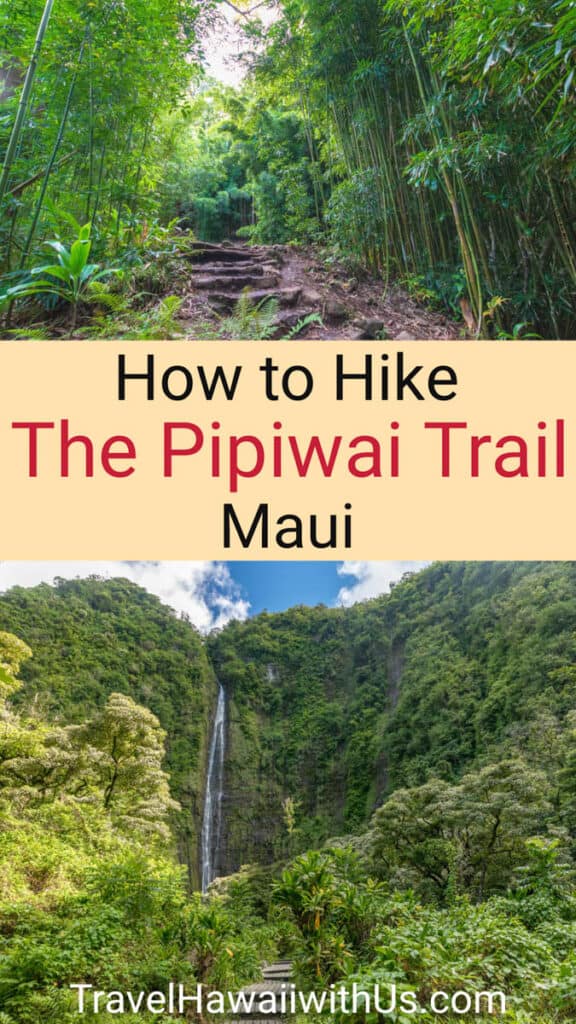
Disclaimer
All information provided on this blog is for informational purposes only and is subject to our terms and conditions of use. It is not a substitute for information or advice from official agencies or qualified professionals.
SV Travel Media LLC makes no representations or warranties regarding the accuracy or completeness of the information provided here, and readers should use their own discretion and judgement, and seek advice from professionals where needed.
Your use of the information described in, and your participation in activities presented on our website may carry the risk of illness, bodily injury, disability, death, or property damage. You freely assume all risks and dangers that may occur as a result of your access, use, purchase, or participation in any information, activity, product, or service listed on our website.

